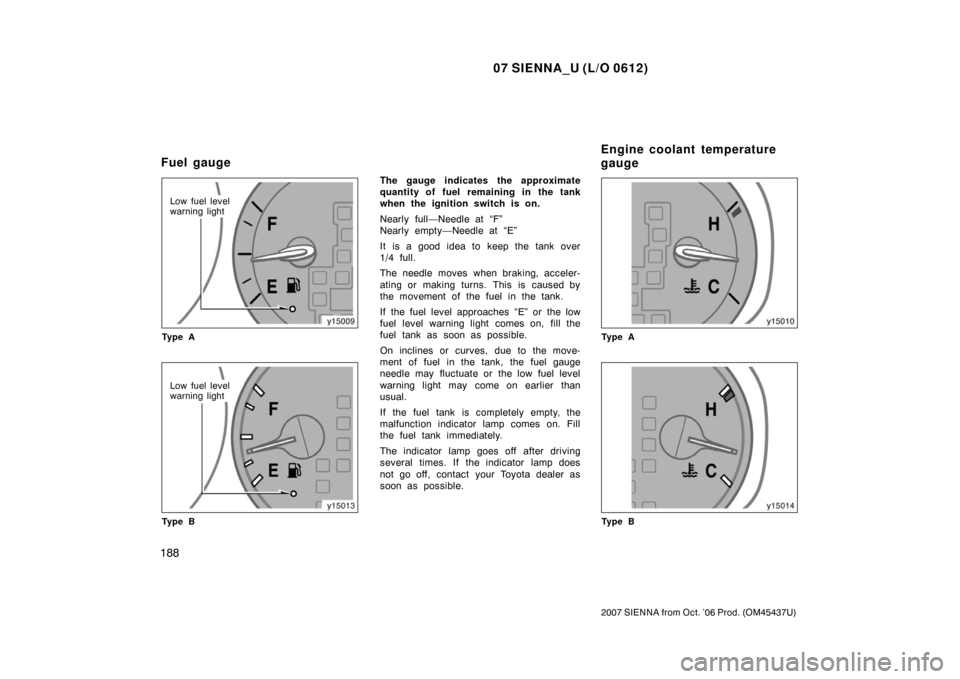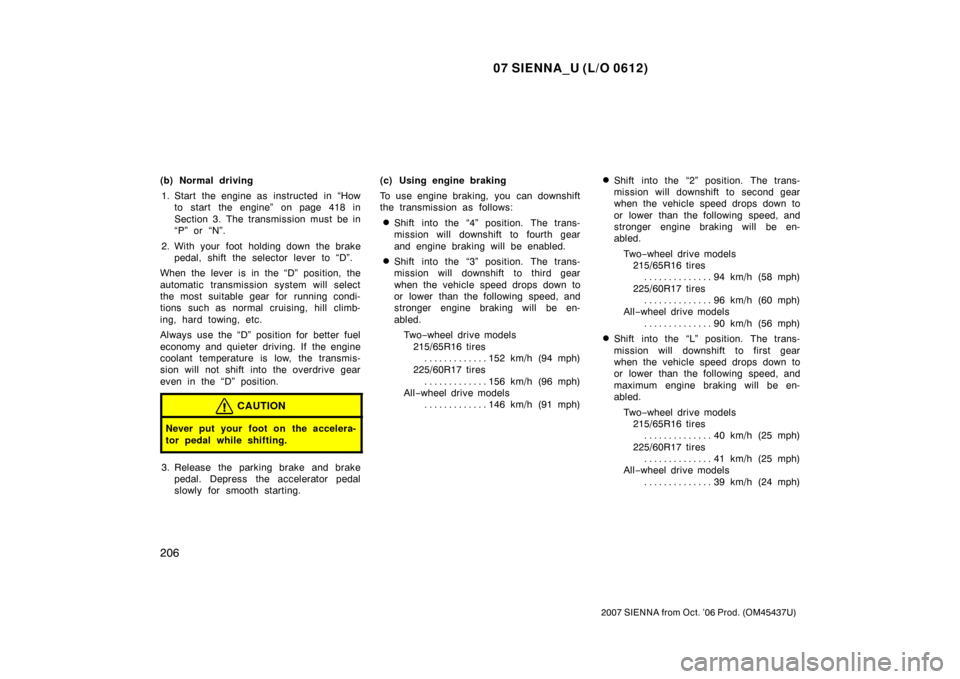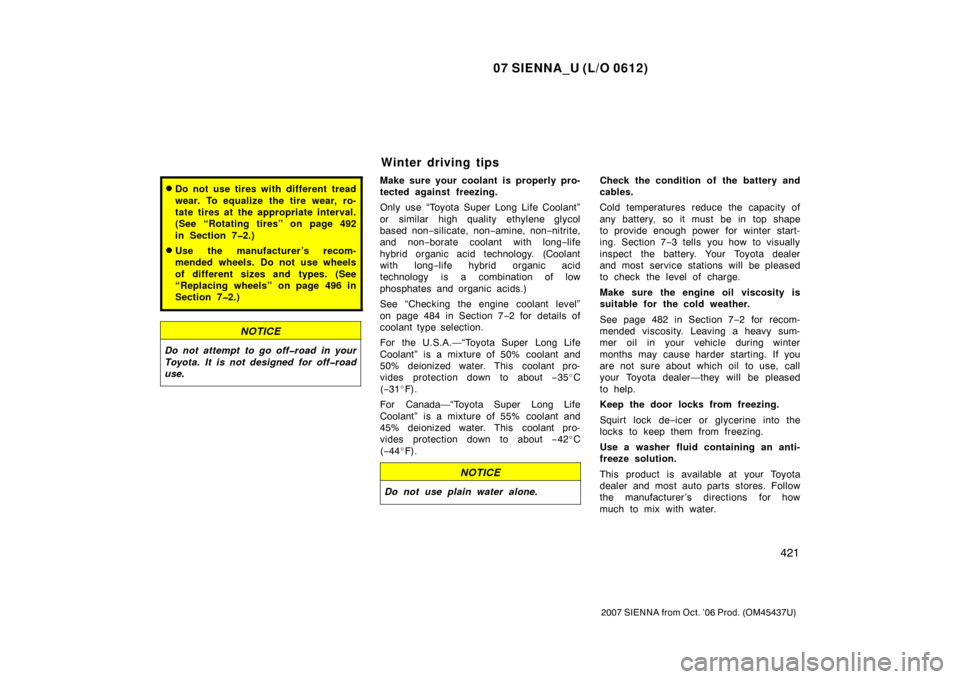Page 13 of 534
07 SIENNA_U (L/O 0612)
5
2007 SIENNA from Oct. ’06 Prod. (OM45437U)
1. Service reminder indicators andindicator lights
2. Speedometer
3. Engine coolant temperature gauge 4. Low fuel level warning light
5. Fuel gauge
6. Trip meter reset knob/instrument panel
light control knob 7. Odometer and two trip meters
8. Tachometer
Instrument cluster overview
�
Ty p e A
Page 14 of 534
07 SIENNA_U (L/O 0612)
6
2007 SIENNA from Oct. ’06 Prod. (OM45437U)
1. Service reminder indicators andindicator lights
2. Speedometer
3. Engine coolant temperature gauge
4. Low fuel level warning light 5. Fuel gauge
6. Dynamic laser cruise control master
warning light
7. Dynamic laser cruise control display 8. Trip meter reset knob/instrument panel
light control knob
9. Odometer and two trip meters
10. Tachometer
�
Ty p e B
Page 195 of 534
07 SIENNA_U (L/O 0612)
187
2007 SIENNA from Oct. ’06 Prod. (OM45437U)
OPERATION OF INSTRUMENTS AND
CONTROLS
Gauges, Meters and Service reminder indicators
Fuel gauge188
. . . . . . . . . . . . . . . . . . . . . . . . . . . . . . . . . . . . .\
. . . . . . . . . . .
Engine coolant temperature gauge 188
. . . . . . . . . . . . . . . . . . . . . . . . . . .
Tachometer 189
. . . . . . . . . . . . . . . . . . . . . . . . . . . . . . . . . . . . \
. . . . . . . . . . . .
Odometer and two trip meters 190
. . . . . . . . . . . . . . . . . . . . . . . . . . . . . . . .
Service reminder indicators and warning buzzers 191
. . . . . . . . . . . . . .
SECTION 1� 6
Page 196 of 534

07 SIENNA_U (L/O 0612)
188
2007 SIENNA from Oct. ’06 Prod. (OM45437U)
Low fuel level
warning light
Ty p e A
Low fuel level
warning light
Ty p e B
The gauge indicates the approximate
quantity of fuel remaining in the tank
when the ignition switch is on.
Nearly full—Needle at “F”
Nearly empty—Needle at “E”
It is a good idea to keep the tank over
1/4 full.
The needle moves when braking, acceler-
ating or making turns. This is caused by
the movement of the fuel in the tank.
If the fuel level approaches “E” or the low
fuel level warning light comes on, fill the
fuel tank as soon as possible.
On inclines or curves, due to the move-
ment of fuel in the tank, the fuel gauge
needle may fluctuate or the low fuel level
warning light may come on earlier than
usual.
If the fuel tank is completely empty, the
malfunction indicator lamp comes on. Fill
the fuel tank immediately.
The indicator lamp goes off after driving
several times. If the indicator lamp does
not go off, contact your Toyota dealer as
soon as possible.
Ty p e A
Ty p e B
Fuel gauge Engine coolant temperature
gauge
Page 197 of 534

07 SIENNA_U (L/O 0612)
189
2007 SIENNA from Oct. ’06 Prod. (OM45437U)
The gauge indicates the engine coolant
temperature when the ignition switch is
on. The engine operating temperature
will vary with changes in weather and
engine load.
If the needle moves into the red zone,
your engine is too hot. If your vehicle
overheats, stop your vehicle and allow the
engine to cool.
Your vehicle may overheat during severe
operating conditions, such as:
�Driving up a long hill on a hot day.
�Reducing speed or stopping after high
speed driving.
�Idling for a long period with the air
conditioning on in stop−and− go traffic.
�Towing a trailer.
NOTICE
�Do not remove the thermostat in
the engine cooling system as this
may cause the engine to overheat.
The thermostat is designed to con-
trol the flow of coolant to keep the
temperature of the engine within
the specified operating range.
� Do not continue driving with an
overheated engine. See “If your ve-
hicle overheats” on page 436 in
Section 4.
The tachometer indicates engine speed
in thousands of rpm (revolutions per
minute). Use it while driving to select
correct shift points and to prevent en-
gine lugging and over�revving.
Driving with the engine running too fast
causes excessive engine wear and poor
fuel economy. Remember, in most cases
the slower the engine speed, the greater
the fuel economy.
NOTICE
Do not let the indicator needle get
into the red zone. This may cause
severe engine damage.
Tachometer
Page 214 of 534

07 SIENNA_U (L/O 0612)
206
2007 SIENNA from Oct. ’06 Prod. (OM45437U)
(b) Normal driving1. Start the engine as instructed in “How to start the engine” on page 418 in
Section 3. The transmission must be in
“P” or “N”.
2. With your foot holding down the brake pedal, shift the selector lever to “D”.
When the lever is in the “D” position, the
automatic transmission system will select
the most suitable gear for running condi-
tions such as normal cruising, hill climb-
ing, hard towing, etc.
Always use the “D” position for better fuel
economy and quieter driving. If the engine
coolant temperature is low, the transmis-
sion will not shift into the overdrive gear
even in the “D” position.
CAUTION
Never put your foot on the accelera-
tor pedal while shifting.
3. Release the parking brake and brake pedal. Depress the accelerator pedal
slowly for smooth starting. (c) Using engine braking
To use engine braking, you can downshift
the transmission as follows:
�Shift into the “4” position. The trans-
mission will downshift to fourth gear
and engine braking will be enabled.
�Shift into the “3” position. The trans-
mission will downshift to third gear
when the vehicle speed drops down to
or lower than the following speed, and
stronger engine braking will be en-
abled.
Tw o −wheel drive models
215/65R16 tires 152 km/h (94 mph)
. . . . . . . . . . . . .
225/60R17 tires
156 km/h (96 mph)
. . . . . . . . . . . . .
All −wheel drive models
146 km/h (91 mph)
. . . . . . . . . . . . .
�Shift into the “2” position. The trans-
mission will downshift to second gear
when the vehicle speed drops down to
or lower than the following speed, and
stronger engine braking will be en-
abled.
Tw o −wheel drive models
215/65R16 tires 94 km/h (58 mph)
. . . . . . . . . . . . . .
225/60R17 tires 96 km/h (60 mph)
. . . . . . . . . . . . . .
All −wheel drive models
90 km/h (56 mph)
. . . . . . . . . . . . . .
�Shift into the “L” position. The trans-
mission will downshift to first gear
when the vehicle speed drops down to
or lower than the following speed, and
maximum engine braking will be en-
abled.
Tw o −wheel drive models
215/65R16 tires 40 km/h (25 mph)
. . . . . . . . . . . . . .
225/60R17 tires 41 km/h (25 mph)
. . . . . . . . . . . . . .
All −wheel drive models
39 km/h (24 mph)
. . . . . . . . . . . . . .
Page 416 of 534

07 SIENNA_U (L/O 0612)
408
2007 SIENNA from Oct. ’06 Prod. (OM45437U)
Ti r e relat ed ter mMeaning
Accessory weight
the combined weight (in excess of those standard items which may be
replaced) of automatic transmission, power steering, power brakes, power
windows, power seats, radio, and heater, to the extent that these items
are available as factory−installed equipment (whether installed or not)
Cold tire inflation pressure
tire inflation pressure when the vehicle has been parked for at least 3
hours or more, or it has not been driven more than 1.5 km or 1 mile
under that condition
Curb weight
the weight of a motor vehicle wi th standard equipment including the
maximum capacity of fuel, oil, and coolant, and, if so equipped, air
conditioning and additional weight optional engine
Intended outboard sidewall
(A) the sidewall that contains a whitewall, bears white lettering or bears manufacturer, brand, and/or model name molding that is higher or
deeper than the same molding on th e other sidewall of the tire, or
(B) the outward facing sidewall of an asymmetrical tire that has a particular side that must always face outward when mounted on a vehicle
Maximum inflation pressurethe maximum cold inflation pressure to which a tire may be inflated and it
is shown on the sidewall of the tire
Maximum loaded vehicle weight
t he sum of —
(a) curb weight;
(b) accessory weight;
(c) vehicle capacity weight; and
(d) production options weight
—Glossary of tire terminology
Page 429 of 534

07 SIENNA_U (L/O 0612)
421
2007 SIENNA from Oct. ’06 Prod. (OM45437U)
�Do not use tires with different tread
wear. To equalize the tire wear, ro-
tate tires at the appropriate interval.
(See “Rotating tires” on page 492
in Section 7�2.)
�Use the manufacturer ’s recom-
mended wheels. Do not use wheels
of different sizes and types. (See
“Replacing wheels” on page 496 in
Section 7�2.)
NOTICE
Do not attempt to go off�road in your
Toyota. It is not designed for off�road
use.
Make sure your coolant is properly pro-
tected against freezing.
Only use “Toyota Super Long Life Coolant”
or similar high quality ethylene glycol
based non−silicate, non −amine, non −nitrite,
and non− borate coolant with long −life
hybrid organic acid technology. (Coolant
with long −life hybrid organic acid
technology is a combination of low
phosphates and organic acids.)
See “Checking the engine coolant level”
on page 484 in Section 7 −2 for details of
coolant type selection.
For the U.S.A.—“Toyota Super Long Life
Coolant” is a mixture of 50% coolant and
50% deionized water. This coolant pro-
vides protection down to about −35 �C
( − 31 �F).
For Canada—“Toyota Super Long Life
Coolant” is a mixture of 55% coolant and
45% deionized water. This coolant pro-
vides protection down to about −42 �C
( − 44 �F).
NOTICE
Do not use plain water alone.
Check the condition of the battery and
cables.
Cold temperatures reduce the capacity of
any battery, so it must be in top shape
to provide enough power for winter start-
ing. Section 7− 3 tells you how to visually
inspect the battery. Your Toyota dealer
and most service stations will be pleased
to check the level of charge.
Make sure the engine oil viscosity is
suitable for the cold weather.
See page 482 in Section 7 −2 for recom-
mended viscosity. Leaving a heavy sum-
mer oil in your vehicle during winter
months may cause harder starting. If you
are not sure about which oil to use, call
your Toyota dealer—they will be pleased
to help.
Keep the door locks from freezing.
Squirt lock de −icer or glycerine into the
locks to keep them from freezing.
Use a washer fluid containing an anti-
freeze solution.
This product is available at your Toyota
dealer and most auto parts stores. Follow
the manufacturer ’s directions for how
much to mix with water.
Winter driving tips